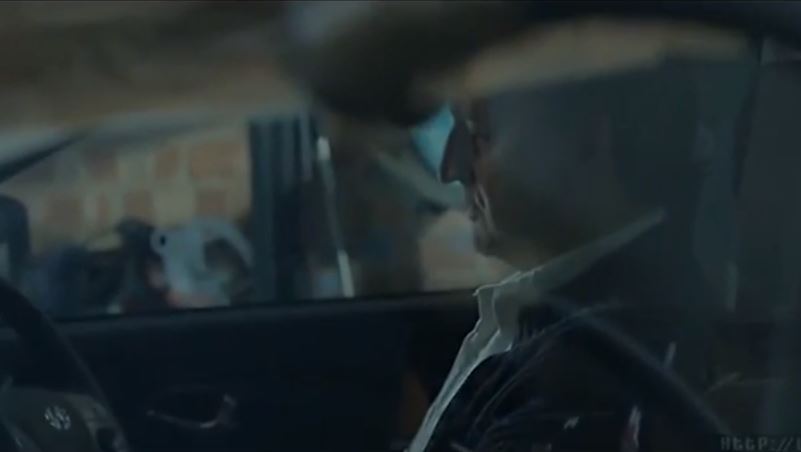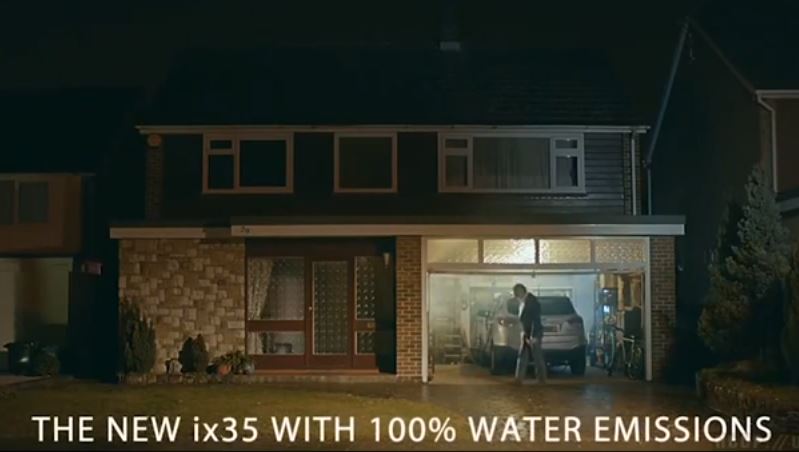
As much as we might bemoan their very existence when they interrupt our favourite TV shows or appear ad nauseam prior to YouTube clips, when done well ads can be genuinely entertaining. With each shot written, debated, edited and otherwise laboured over sometimes for hundreds of hours, successful ads become pop culture in their own right and are often of higher quality than the shows whose commercial crevices they are stuffed into.
An ad recently aired in the UK, however, become a talking point for all the wrong reasons when it depicted a man trying to kill himself by breathing in the exhaust fumes produced by what transpires to be a particularly environmentally friendly type of vehicle: Hyundai’s iX35.
In the ad for its new car, the Korean automobile manufacturer shows a middle-aged man attempting to commit suicide by connecting a length of hose to his car’s exhaust and, with the other end of the pipe lodged in the passenger window, switching the engine on while parked inside a closed garage. After hearing the sounds of duct-tape being fastened to the hose pipe and the engine running, we watch as the forlorn-looking man sits in the driver’s seat inhaling the fumes and waiting to die.
The 60-second commercial culminates with the same man emerging from his garage completely unharmed, trudging across our screens and back into his home as we learn via an on-screen message that the iX35’s emissions are, in fact, 100 percent water. The man goes on to, perhaps, live another day.
The best ads are often surprising, even shocking, but few are remembered fondly when they make light of such things as suicide or self harm. Despite ending well (in the sense that the male character did not manage to end his life on this occasion), the ad was considered distasteful and disturbing by many viewers, least not those whose lives have been touched by suicide in some way.
On her personal blog, London-based copywriter Holly Brockwell responded to the Hyundai ad with a heartfelt letter, describing how the ad brought memories of her own father’s suicide flooding back.
“As an advertising creative, I would like to congratulate you on achieving the visceral reaction we all hope for. On prompting me to share it on my Twitter page and my blog. I would not like to congratulate you on making me cry for my dad.
When your ad started to play, and I saw the beautifully-shot scenes of taped-up car windows with exhaust feeding in, I began to shake. I shook so hard that I had to put down my drink before I spilt it. And then I started to cry. I remembered looking out of the window to see the police and ambulance, wondering what was happening. I remember mum sitting me down to explain that daddy had gone to sleep and would not be waking up, and no, he wouldn’t be able to take me to my friend’s birthday party next week. No, he couldn’t come back from heaven just for that day, but he would like to if he could. I remember finding out that he had died holding my sister’s soft toy rabbit in his lap.
Surprisingly, when I reached the conclusion of your video, where we see that the man has in fact not died thanks to Hyundai’s clean emissions, I did not stop crying. I did not suddenly feel that my tears were justified by your amusing message. I just felt empty. And sick. And I wanted my dad.”
The video, titled “Pipe Job”, has since been removed from many YouTube channels on Hyundai or its advertising agency Innocean’s request. Although we cannot guarantee that it will remain visible for long, those of you who would like to see the offending material for yourselves can do so here. UPDATE: The video has since been removed, sorry guys.
http://www.youtube.com/watch?feature=player_embedded&v=0ZZyiZY5rDE
Source: Yahoo! Japan News Copybot (Holly Brockwell”s personal blog)
Video/caps: YouTube



 Japanese Twitter reacts to Logan Paul’s “Japanese Suicide Forest” video
Japanese Twitter reacts to Logan Paul’s “Japanese Suicide Forest” video Chinese couple’s suicide attempt leads to serious injury, criminal charges, and $24,000 in damages
Chinese couple’s suicide attempt leads to serious injury, criminal charges, and $24,000 in damages Councilman Super Crazy Kun begins work, but considerably less crazy looking
Councilman Super Crazy Kun begins work, but considerably less crazy looking This ad for Ueno Clinic makes no sense… until you realize what the clinic specializes in【Video】
This ad for Ueno Clinic makes no sense… until you realize what the clinic specializes in【Video】 Japan’s suicide number drops for eighth straight year, rises among teens
Japan’s suicide number drops for eighth straight year, rises among teens Let’s go open a Lego Japan lucky bag…o
Let’s go open a Lego Japan lucky bag…o Square Enix releases a Final Fantasy fukubukuro lucky bag for New Year’s in Japan
Square Enix releases a Final Fantasy fukubukuro lucky bag for New Year’s in Japan What’s in Starbucks Japan’s fukubukuro lucky bag for 2025?
What’s in Starbucks Japan’s fukubukuro lucky bag for 2025? Is the Krispy Kreme fukubukuro lucky bag in Japan good value for money?
Is the Krispy Kreme fukubukuro lucky bag in Japan good value for money? Animate Akihabara releases a lucky bag for the first time in years, and it’s amazing
Animate Akihabara releases a lucky bag for the first time in years, and it’s amazing Second-hand video game fukubukuro lucky bags reveal nostalgic surprises
Second-hand video game fukubukuro lucky bags reveal nostalgic surprises Sacrificing bears for amazing hotpots with Kuma-chan Onsen’s fukubukuro lucky bag
Sacrificing bears for amazing hotpots with Kuma-chan Onsen’s fukubukuro lucky bag Is there a big difference between Starbucks Japan’s fukubukuro lucky bags?
Is there a big difference between Starbucks Japan’s fukubukuro lucky bags? Hayao Miyazaki says Happy New Year to Studio Ghibli fans with new art for Year of the Snake
Hayao Miyazaki says Happy New Year to Studio Ghibli fans with new art for Year of the Snake Family Mart releases a fukubukuro lucky bag packed with cool Convenience Wear
Family Mart releases a fukubukuro lucky bag packed with cool Convenience Wear The top 10 annoying foreign tourist behaviors on trains, as chosen by Japanese people【Survey】
The top 10 annoying foreign tourist behaviors on trains, as chosen by Japanese people【Survey】 McDonald’s Japan has a fukubukuro lucky bag that everyone wants to get their hands on
McDonald’s Japan has a fukubukuro lucky bag that everyone wants to get their hands on Pokémon fans aren’t happy with the Mister Donut fukubukuro lucky bag for 2025
Pokémon fans aren’t happy with the Mister Donut fukubukuro lucky bag for 2025 Kura Sushi has secret menu items in Japan, and here’s how to find them
Kura Sushi has secret menu items in Japan, and here’s how to find them After being snatched up by scalpers, Sailor Moon chocolate returns in officially marked-up complete box
After being snatched up by scalpers, Sailor Moon chocolate returns in officially marked-up complete box Bear breaks into house in Japan, quickly begins spending winter exactly like Japanese people do
Bear breaks into house in Japan, quickly begins spending winter exactly like Japanese people do Why are there so many Hokkaido food fairs in Japanese department stores these days?
Why are there so many Hokkaido food fairs in Japanese department stores these days? The perfect budget-friendly hot spring hotel near Narita Airport
The perfect budget-friendly hot spring hotel near Narita Airport J-pop mega star Ado reveals she’s been living in the U.S., may not understand language acquisition
J-pop mega star Ado reveals she’s been living in the U.S., may not understand language acquisition Starbucks Japan is calling it quits with paper straws
Starbucks Japan is calling it quits with paper straws Japan’s most popular castle raising ticket prices by up to 200 percent for non-local tourists
Japan’s most popular castle raising ticket prices by up to 200 percent for non-local tourists Japanese company develops classy heavy metal band frames for glasses
Japanese company develops classy heavy metal band frames for glasses This downtown Tokyo cafe is like a time machine that takes you back 50 years into the past
This downtown Tokyo cafe is like a time machine that takes you back 50 years into the past Station of despair: What to do if you get stuck at the end of Tokyo’s Chuo Rapid Line
Station of despair: What to do if you get stuck at the end of Tokyo’s Chuo Rapid Line Starbucks Japan reveals new winter holiday goods to wrap up 2024
Starbucks Japan reveals new winter holiday goods to wrap up 2024 McDonald’s new Happy Meals offer up cute and practical Sanrio lifestyle goods
McDonald’s new Happy Meals offer up cute and practical Sanrio lifestyle goods Foreign tourists on Shinkansen bullet train break suitcase etiquette, angering local passengers
Foreign tourists on Shinkansen bullet train break suitcase etiquette, angering local passengers Possessing Harry Potter’s Sword of Godric Gryffindor is now illegal in Japan
Possessing Harry Potter’s Sword of Godric Gryffindor is now illegal in Japan [Deleted] Article written for April Fool’s Day 2018
[Deleted] Article written for April Fool’s Day 2018 Japanese government to make first change to romanization spelling rules since the 1950s
Japanese government to make first change to romanization spelling rules since the 1950s Foreigner’s request for help in Tokyo makes us sad for the state of society
Foreigner’s request for help in Tokyo makes us sad for the state of society Japanese convenience store Family Mart announces abolishment of eat-in spaces
Japanese convenience store Family Mart announces abolishment of eat-in spaces Life-size vibrating Legend of Zelda Master Sword for sale from Nintendo【Photos】
Life-size vibrating Legend of Zelda Master Sword for sale from Nintendo【Photos】 Princesses, fruits, and blacksmiths: Study reveals the 30 most unusual family names in Japan
Princesses, fruits, and blacksmiths: Study reveals the 30 most unusual family names in Japan Studio Ghibli releases free-download board game — Here’s how to play it without reading Japanese
Studio Ghibli releases free-download board game — Here’s how to play it without reading Japanese Unexpected Japan suicide facts are equal parts depressing and uplifting
Unexpected Japan suicide facts are equal parts depressing and uplifting Japanese coder finds perfect way to incorporate ads into games
Japanese coder finds perfect way to incorporate ads into games Chinese engineer makes own robot wife to get parents off his back
Chinese engineer makes own robot wife to get parents off his back Microsoft pulls game inspired by Logan Paul’s infamous suicide forest video from Xbox Store
Microsoft pulls game inspired by Logan Paul’s infamous suicide forest video from Xbox Store Outrage sparked: Tokyo truck driver abandons body of suicide victim, claims the body was a “doll”
Outrage sparked: Tokyo truck driver abandons body of suicide victim, claims the body was a “doll” Japanese supermarket’s funeral ad sparks controversy, debate over “blasphemy”
Japanese supermarket’s funeral ad sparks controversy, debate over “blasphemy” Rubbernecking gone too far? Net users react to crowds taking pics of train hit by suicide jumper
Rubbernecking gone too far? Net users react to crowds taking pics of train hit by suicide jumper Mr. Sato takes a stroll in his USB Pollen Blocker: “Felt great but it was a struggle to order coffee”
Mr. Sato takes a stroll in his USB Pollen Blocker: “Felt great but it was a struggle to order coffee” Toyota’s official anime itasha car finds a home
Toyota’s official anime itasha car finds a home 2014 suicide rates in Japan down, suicide in men still twice that of women
2014 suicide rates in Japan down, suicide in men still twice that of women Kyoto counter-terrorism unit called in after senior citizen “reserves” parking space
Kyoto counter-terrorism unit called in after senior citizen “reserves” parking space Crazy-cheap Japanese apartment for less than 140 bucks a month comes with headaches every day
Crazy-cheap Japanese apartment for less than 140 bucks a month comes with headaches every day Japan’s Prime Minister says he didn’t want to cosplay as Mario at the 2016 Olympics
Japan’s Prime Minister says he didn’t want to cosplay as Mario at the 2016 Olympics Fireman photographs female in bath, gets chased by parents, drives off with mother on bonnet
Fireman photographs female in bath, gets chased by parents, drives off with mother on bonnet Japanese commercial perfectly captures what it feels like to chew gum
Japanese commercial perfectly captures what it feels like to chew gum Chinese ad for laundry detergent is remarkably racist
Chinese ad for laundry detergent is remarkably racist
Leave a Reply